

Vol. 38 (Nº 18) Año 2017. Pág. 5
Miguel David ROJAS López 1; Laura Marcela LONDOÑO Vásquez 2; Juan Esteban ALIS Restrepo 3
Recibido: 20/10/16 • Aprobado: 10/11/2016
ABSTRACT: Decision making is a process that happens frequently in people’s lives, which is essential and critical in daily situations. Making the wrong decision could cause unwanted facts; it can lead by a poor strategic planning or even the bankruptcy of a company. Thus, a management game was developed, where tries to show to the participants how team works become an important role in organization’s success. Subsequently, a process of validation of the game is performed and finally the results of individual and team decision making are shown and analyzed. |
RESUMEN: Tomar decisiones es un proceso que se da frecuentemente en la vida de todas las personas, el cual es esencial y crítico en las situaciones cotidianas. Tomar la decisión equivocada puede causar resultados no deseados; puede llevar a un plan estratégico pobre e incluso a la quiebra de una compañía. De esta manera se desarrolló un juego gerencial en el cual se intenta mostrar a los participantes cómo el trabajo en equipo toma un rol importante en el éxito de las organizaciones. Posteriormente se realiza un proceso de validación y se muestran algunos resultados y conclusiones sobre el proceso de toma de decisiones individual y en equipo, obtenidos mediante la aplicación del juego. |
Management games have had a great development recently, rapidly becoming one of the most important and useful tools for training personnel in companies, or teaching new skills or knowledge and reinforcing some concepts in students or workers (Janodia, Sreedhar, Ligade & Udupa. 2008).
Traditionally, games have been used to train and develop non-technical skills in individuals and students, and more recently are being used for preparation of operational teams. Games work as systems, so games can be represented as a set of elements that interact with their environment for a common goal: fun (Niño, Tobas & lemo, 2011).
However, games also help decision makers to simulate situations, enhance experience and accumulate memories, leading to a rapid response and to accelerate reaction capacity in daily situations (Lauche, Crichton & Saskia, 2009).
Tactical decision games are used for training decision making in different environments in daily situations and especially in critical moments of a company, using teaching techniques as exercises, simulations, case studies, conferences, lectures, among others. One of the principal characteristics of a tactical decision game is to develop a difficult and complex scenario which leads to a dilemma or unusual situation (Flin, 1996).
This type of games are designed specifically to introduce the players to a dilemma or to a difficult daily situation, where is not easy to obtain the "correct" answer, and it is not obvious. Players have to use their prior knowledge and experience to assess the situation and find a possible solution to the problem (NIFC, 2003).
As stated above, the necessity of designing a game oriented to develop management skills is identified, which needs to be focused on teaching the factors that affect the decision making process and the identification of factors and involved variables in the process. Similarly, the big deal of the game is to show how the different ways of decision-making become successful key factors for effective teamwork.
Following, some basic concepts of management games, decision making process and teamwork are shown, central topics for the design and application of the game Gerenciarte. Then the methodology, validation and results of the game are described.
The term "Game" refers to the development of an interaction situation between participants, subject to specific rules and associated to certain payments related to their possible outcomes (Vega, 2000). Games as a free action or occupation, which is developed within certain temporal and spatial boundaries, as mandatory rules freely accepted (Bernabeu & Goldstein, 2012).
Recent games are used as training tools and learning in different settings such as schools, universities and organizations; (Echeverría et al., 2011); (Kebritchi & Hirumi, 2008) suggest that games for educational purposes are effective tools for teaching complex skills and procedures. Games are important because use action instead of explanation, create motivation, accommodate multiple learning styles, reinforce skills and provides interactive contexts.
Results are conditioned to correct decision making during the game, thus, it is necessary to create a strategy to obtain satisfactory results, which will undoubtedly be affected by the change of variables not easily manipulated or controlled by players, but that due to a strategic decision can be transformed into more efficient (Cohen & Rhenman, 1961).
Within management games are some applications to strengthen specific areas such as finance, software design and operational control (Plata, 2008); but games are also used for personnel preparation in companies or to teach and reinforce knowledge to students.
“Decision making is the study of identifying and choosing alternatives based on the decision maker’s values and preferences. Making a decision implies that there are alternative choices to be considered, and in such a case we want not only to identify as many of these alternatives as possible but to choose the one that best fits with our goals, objectives, desires, values, and so on” (Fülöp, 2005).
It is important to define the difference between solving a problem and decision a making, because these two concepts are complementary each other. Problem solving is a continuous, conscious process which seeks to reduce or correct the difference between the actual and desired conditions. Decision making is one of the steps in the process of problem solving.
There are several approaches to the decision making process that take into account different phases and factors involved, which differ according to the author. Following, an approximation of the decision making process is made (Fülöp, 2005):
But the decision is not always made individually; usually in companies are teamworks to make decisions. Therefore, it is important to strengthen and enhance the skills of each team member, to make an effective decision.
“Group decision is usually understood as aggregating different individual preferences on a given set of alternatives to a single collective preference” (Fülöp, 2005), in current processes each team member have different skills, knowledge and experiences that could influence the way they conceive the problem and the solution alternatives.
Globalization demands organizations with the intention of changing their strategies, giving importance to innovation and the generation of knowledge; a suitable tool to achieve this change is teamwork, which must be progressively developed in organizations, taking into account the dynamic environment and constant developments in technology. This obliges organizations to cooperate and join forces, to consolidate instructions, activities and develop flexible communication channels, through effective teamwork (Brunner, 2010).
However, teams are not always effective and efficient, and occasionally fail to achieve the high performance expected from them. Therefore it is essential to train team members to get the best from them.
A common and present problem in some organizations is to group a set of different people to achieve an organizational purpose or firm’s goals; this is difficult because every person has necessities, interests, knowledge and experiences, expectations and different motivations, forming a diverse team (Hellriegel, Slocum & Woodman, 1999). The function of a leader is to consolidate the variety of expectations into a common one, and join the members as an oriented team with the same goals and horizons.
It is important to differentiate between group work and teamwork. Group work is a group of people that do activities and have a manager that directs them and indicates what to do, how to do it, the time to do it and finally communicates the expected results; Members of the group do what they are told separately and in an individual way. On the other hand, Teamwork is a “group of persons that work together in a synergic way to achieve a common goal” (Stoner, Freeman & Gilbert, 1996).
Table 1. Difference between group work and teamwork.
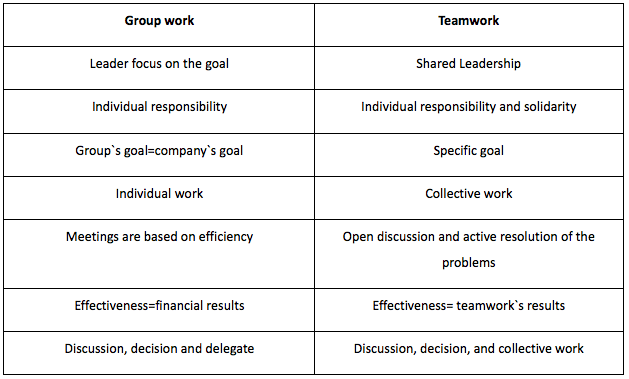
Teamwork is conformed by people committed to the achievement of common and defined goals and objectives, sharing methods and/or economic resources, with complementary skills and knowledge, so that the team´s achievement is greater than the sum of the successes of the individual efforts (Oliveros & Cova, 2009). Efficient teams have (Koontz & Weihrich, 1998): (See Table 1)
Table 2. Characteristics of effective teams.
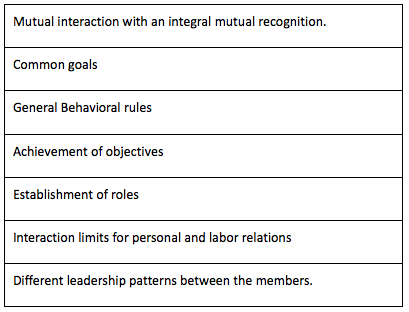
However, not all teams work in the correct way, principally because people have not been properly educated to work as a team member, to contribute to the team success (Oliveros & Cova, 2009).
Problems in teamwork are common, generally because of different personalities, behaviors and temperaments of the members. These individual and group difficulties have to be identified by the leader, who has to analyze them and develop corrections if it is necessary, to maintain a comfortable work environment.
In the game is expected that teamwork improves individual results in decision making, team discussion is encouraged and that team members find mechanisms to agree and take successful decisions, within the time constraints.
For the design of the game with educational purposes Gerenciarte, a methodology proposed in the School of Mines, National University of Colombia is used. It is composed of 10 fundamental steps (Gómez, 2010):
In Table 2 the design of the game Manage-art and the results obtained with the mentioned methodology are shown.
Table 3. Methodology and Game Design Gerenciarte.
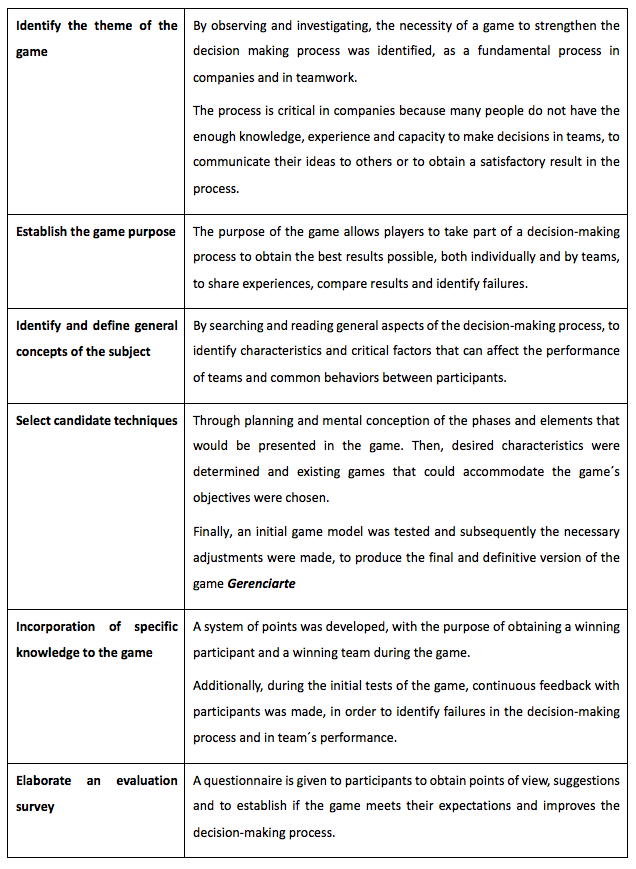
The game is a specific situation within a company that has problems and crisis. Players have different alternatives or possibilities to solve the company´s problem, but they have to make decisions to save the company by establishing an order of importance for the different alternatives presented and obtain a sequence. The objective of the game is to enumerate the alternatives in the best possible order, to save the company.
The same problem is given to all participants, and each one has 5 to 10 minutes to classify the 10 proposed alternatives in order of importance. During this time, players cannot talk to other people or use any electronic devices. The game in the first stage is individual. Two alternatives should not be used in the sequence to save the company, and participants have to decide, which shall not be in the final list.
After people have solved the problem individually, they conform teams of 4 to 5 people. People are assigned randomly to teams by the game coordinator, in the following way:
Each group will have 20 minutes to discuss, analyze, evaluate and examine each alternative and the individual results of each team member, with the objective of obtaining a common response to the problem by consensus, authoritarianism, or democracy, among others. Finally, collective, optimal and individual results are compared to establish differences, discuss them and obtain conclusions about the individual and team decision making process.
Winner is the person or the team who have all, or most of the alternatives presented, in the order established by the experts. To determine who is the winner, scores will be given to the sequence. For each correct answer 5 points will be given, if the answer is a place above or below the correct answer 3 points will be given and if the answer is 2 places above or below the correct answer 1 point will be given. If unused options are correct, 5 points will be given for each answer, regardless of their order. The maximum score of the game is 50 points, 5 points for each correct answer; it corresponds to the optimal sequence and 5 additional points for the non-used options.
The optimal sequence for the situation was established by four experts in the field of management, finance and strategic planning (Four professors from the National University of Colombia, Medellin Campus), although they did not have the same answers, the results showed a trend with which the optimal result was defined.
The game focuses on teamwork, tactical decisions making individually or by teams, situation control, common welfare, logical steps to obtain the best solution possible and competition between teams to obtain the most logical response.
The final game was applied to a group of 17 students and 1 teacher of Project Management a postgraduate program, in National University of Colombia, Medellin Campus, School of Mines. The objective was to show participants the importance of decision making and the influence of some people in teamworks.
Initially the game was played individually and then 2 groups of 4 people were formed, the group # 1 was conformed by women and the group # 2 by men, Groups # 3 and # 4 of 5 people each one were mixed, the teacher of the group was in the group # 4. Figure 1 shows the results of the game; individual, group and team average.
Figure 1. First results of the game Gerenciarte
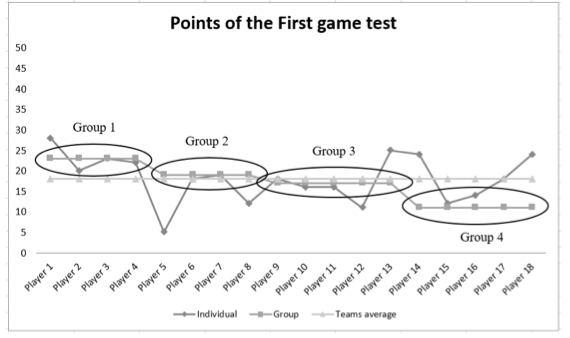
Nobody obtained the optimal sequence of alternatives to save the company, however most of the groups improved upon the individual performance of its participants, which initially indicates that is better and more efficient to have a team to discuss and decide, in the decision making process.
Group # 1 formed only by women, obtained the best results, both individual and group. Its results did not improve in group as expected, but remained stable. Player # 1 had better individual results.
Group # 2 formed only by men, obtained good team results, however player #5 had the worse individual results and had a great improvement. Teamwork improved the results of all team members, even exceeding the group average.
Group # 3 formed by women and men, obtained good individual and team results, very close to the group average. All team members had similar results and these were maintained in the group.
Group # 4 formed by women and men, included the teacher. Player # 15 (The teacher) had the worst individual results of the team; other team members had good individual results even above the group average. In this group, teamwork did not produce satisfactory results, because the presence of a possible expert in the subject (the teacher) apparently changed the thinking of the other team members.
The game was applied a second time to a group of 24 students of the Management Games a postgraduate program, at National University of Colombia, Medellin Campus, School of Mines. The objective was to show students the way a group training game is designed and implemented, in order for participants to obtain bases to design, validate and apply their own games.
The game was played individually and then 4 groups of 5 people and 1 group of 4 people were formed, the group # 1 was conformed by women and the group # 2 by men, Groups # 3, #4 and # 5 were mixed. In Figure 2 individual, team and average results of the second game are shown.
Figure 2. Second results of the game Gerenciarte.
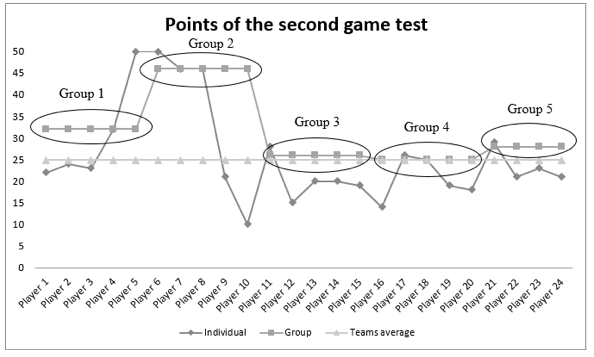
Something particular in second results is that two participants, players # 5 and # 6 found the optimal sequence of alternatives when playing individually, but in teams they did not obtain the same results.
Group # 1 conformed only by women, had a participant with one of the best individual results and they obtained the second best result by a team, however it was expected that the person with the highest individual score, had more influence in other team members, based on clear arguments and individual experience.
Group # 2 formed only by men, had 3 of the 4 participants with the best individual results, but also had the player with the worst individual score. Their teamwork was successful because players with good results influenced the other 2 players, obtaining the best group results, very close to the optimal sequence.
Group # 3 formed by women and men, initially had regular individual results compared with the group average, because all team members had scores below average; however, they had a good improvement in team results, close to the group average. Groups # 4 and # 5 formed by women and men both mixed obtained similar results.
The game was applied a third time to a new group of 24 students of project management a postgraduate program, at National University of Colombia, Medellin Campus, School of Mines. As previous tests, group # 1 was formed by women and group # 2 by men, Groups # 3, #4 and # 5 were mixed. In Figure 3 individual, team and average results of the third game are shown.
Figure 3. Third results of the game Gerenciarte.
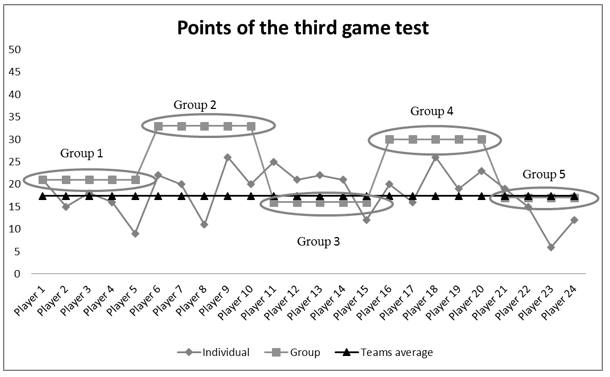
On the third test, three of the five groups improved their individual scores by taking decisions in teams. Group # 1 had similar scores in individual part of the game, however their group score improved. Group # 2, formed by men had the best group results of the game with 34 points, and an improvement of all individual scores. Group # 3 had a different result, because four of the five members of the group got a worse punctuation on team’s phase, that means that in this group, decision making by groups did not work property. Results of group # 4 were similar to group # 2, where all group members improve their individual scores. Group # 5, had the participant with the worst score of the game, however, three of the four participants of the group improved their results, with a score close to the average.
On the fourth test of the game, it was applied to a group of 27 students of the course management simulation of undergraduate program at Institución Universitaria Esumer, Medellin. Groups were formed as previous tests. In Figure 4 individual, team and average results of the fourth game are shown.
Figure 4. Fourth results of the game Gerenciarte.
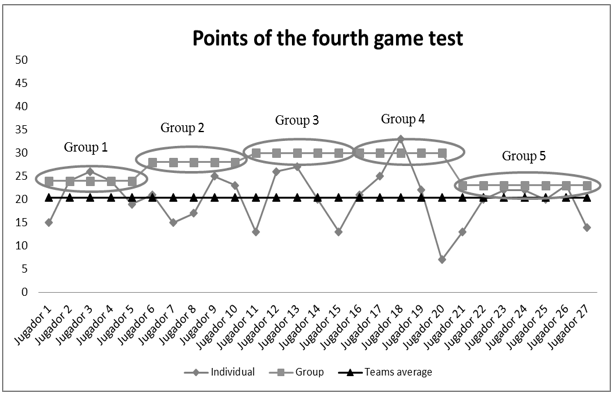
Results of the fourth application of the game showed that only two participants had a worst punctuation making decisions by group and all the groups had higher scores compared with the individual scores of their members.
In Table 4 a comparison between game tests is shown.
Table 4. Comparison of individual scores in the game tests.
|
First Test |
Second Test |
Third Test |
Fourth Test |
Best score |
27 |
50 |
26 |
33 |
Worst score |
5 |
10 |
6 |
7 |
Average |
18 |
25 |
17 |
20 |
In the first test, no one found the correct sequence of alternatives and the best score obtained by a participant was about half of the maximum possible score, in the second test, two participants found the correct sequence and generally better results were obtained, the average was 7 points higher and the worst score was 5 points higher. In the third test and fourth no one found the correct sequence of alternatives. Scores of the third test were similar to the first, with a decrease in one point on each result, while scores of the fourth test were slightly higher with an average of 20 points and a best score of 33 points.
It is possible that difference presented in the test`s results exist because participants in the second group have more training and knowledge in concepts related to management and strategy and participants of the other tests have a more heterogeneous formation, so experience and formation were key factors in the success of game results.
In the first test, women obtained the best team results and in the second, third and fourth tests men obtained them. It is not possible to conclude which genre takes better decisions, but as initial inference, mixed teams results were not as good as women or men teams results.
In almost all teams, individual results improved as expected, but results suggest that the presence of a possible expert produces an opposite results. All results and analyzes presented, are preliminary observations and inferences made by supervise and the application of the game.
Using the game Gerenciarte a group could be trained in different skills such as decision making and teamwork, and also many conclusions about the process, teams and individuals could be made, allowing managers to form high qualified, effective and efficient teams and to take individual and collective corrective actions to improve personal and teams’ performance in companies.
Management games as teaching tools present an opportunity for students, employees and executives to participate in an experience that reinforces the principle of learning by doing, focusing on the development of abilities and skills for management under uncertain conditions, especially in the decision-making process and planning, with continuous feedback and time constraints.
The results obtained before were the product of preliminary tests performed to graduate and udergraduate students, in future work the game will be applied to different groups, in order to obtain statistically significant results and determine specific characteristics and factors involved in the decision making process. Aditionally, the game will be applied to company employees with the objective of training them in decision-making and to allow companies to work on the failures of members and produce efficient and effective teamworks.
Bernabeu, N., and Goldstein, A. (2012). Creatividad y aprendizaje. El juego como herramienta pedagógica. Bogotá: Ediciones de la U.
Brunner, J. (2010). Desafíos de la globalización para la innovación y el conocimiento, Revista Educación Superior y Sociedad, 7(1), 89–96.
Cohen, K. and Rhenman, E. (1961). The Role of Management Games in Education and Research. Management Science. Management Science, (7)2, 131-166.
Echeverría, A., García-Campo, C., Nussbaum, M., Gil, F., Villalta, M., Améstica, M., & Echeverría, S. (2011). A framework for the design and integration of collaborative classroom games. Computers & Education, 57(1), 1127–1136.
Flin, R. (1996). Sitting in the hot seat: Leaders and teams for critical incident management, Wiley, Chichester.
Fülöp, J. (2005). Introduction to Decision Making Methods. Laboratory of Operations Research and Decision Systems, Computer and Automation Institute, Hungarian Academy of Sciences. Available:
http://academic.evergreen.edu/projects/bdei/documents/decisionmakingmethods.pdf [Cited February 2014]
Gómez, M.C. (2010). Definición de un método para el diseño de juegos orientados al desarrollo de habilidades gerenciales como estrategia de entrenamiento empresarial [M.Sc. Thesis]. Medellín: Universidad Nacional de Colombia.
Hellriegel, D., Slocum, J.W. and Woodman, R.W. (1999). Comportamiento Organizacional. Thomson Editores. México.
Janodia, M., Sreedhar, D., Ligade, V. and Udupa, N. (2008). Importance of Management Games in Classroom learning - A perspective. Pharmaceutical Reviews, (6)1.
Kebritchi, M., & Hirumi, A. (2008). Examining the pedagogical foundations of modern educational computer games. Computers & Education, 51(4), 1729–1743.
Koontz, H. and Weihrich, H. (1998). Administración, una perspectiva global. Mc Graw Hill. Onceava edición. México.
Lauche, K., Crichton, M. and Saskia, P. (2009). Tactical Decision Games: Developing Scenario-Based Training for Decision-Making in Distributed Teams, British Computer Society.
NIFC. (2003). Design & Delivery of Tactical Decision Games and table exercises. Leadership toolbox reference, TDGS/STEX. National Interagency Fire Center and the U.S. Marine Corps University.
Niño, M., Tobas, H. and Lemo, J. (2011). Cosmodel: An interaction model for social network games. Dyna. No 170, 59-69.
Oliveros, D. and Cova M. (2009). Desarrollo de Grupos y Equipos de Alto Desempeño [M.Sc. Thesis]. Universidad de Puerto Ordaz.
Plata, J. (2008). Los juegos gerenciales el presente de la gerencia, Grupo de Estudio Money Makers, Bogotá: Universidad Nacional de Colombia.
Rojas, M. (2006). Administración para Ingenierios. Ed.3.159.
Sims, D. E., Salas, E., Burke, C. S. and Wheelan, S. (2005). Promoting effective team performance through training. The handbook of group research and practice, 407–425.
Stoner, J., Freeman, E. and Gilbert, D. (1996). Management. Pearson Education, Ed. 6, 682 páginas
Vega Redondo, F. (2000). Economía y juegos. Barcelona: Antoni Bosch Editor.
1. Ph.D. Associated professor. Universidad Nacional de Colombia. Email: mdrojas@unal.edu.co
2. M.Sc. full time professor, Institución Universitaria Esumer, Ph.D student Universidad Nacional de Colombia. Email: laura.londono@esumer.edu.co – lmlondonov@unal.edu.co
3. M.Sc. Universidad Nacional de Colombia. Email: jealisr@unal.edu.co